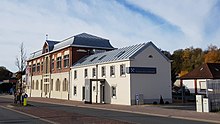Vieille Montagne Museum
The Vieille Montagne Museum is a state-approved museum in the village of Kelmis in the province of Liège . It was set up in 2018 in the former Vieille-Montagne management building , which is under monument protection , and replaced the "Göhl Valley Museum", which had been in the Villa Bruch in Maxstraße since 1984.
history
In 1970 the "Göhl Valley Association" was founded, which wanted to review the history of the Kelmis community and the neighboring towns. Numerous objects and finds as well as press and image material were collected. The Kelmis community provided space in the former villa of the felt cloth manufacturer Reinhard Bruch, which the former sub-community Neu-Moresnet had acquired in 1962 and used as the mayor's office and which came to Kelmis in 1977 after the community merger. In 1984 the Göhltalmuseum was officially opened as a local museum.
As the collections grew, the concept changed from a local to an economic museum. Since the premises were no longer sufficient, the Kelmis community decided in 2014 to purchase the former management building of the Vieille Montagne stock corporation, which had been owned by the Ohn family, and to renovate and renovate it for disabled people. It was finally opened on September 14, 2018 under the new name “Museum Vieille Montagne”. Since then, the museum administration has been subordinate to the Kelmis municipality; the historian Celine Ruess was appointed first director of the new museum.
Concept and structure
In its permanent exhibition , the museum presents the history of the village of Kelmis, the development of which was dependent on the zinc deposits in its immediate vicinity and which, due to national disputes over these mineral resources, became the capital of the small, neutral state that existed from 1815 to 1918 to end political disputes Neutral Moresnet advanced.
The exhibition shows how Kelmis has been in the focus of political interest groups since the Middle Ages due to the various ore deposits and above all calamine and how the professional mining of zinc spar began due to the purchase of the zinc mines by the chemist and inventor Jean-Jacques Dony in 1806 . Furthermore, the exhibition shows how, after Dony's bankruptcy in 1819, the industrial and also associated with the takeover by the banker and entrepreneur François-Dominique Mosselman and his establishment of the Société Anonyme des Mines et Fonderies de Zinc de la Vieille-Montagne in 1837 social upswing in the region. With this social upswing, the region's population rose from around 300 in 1800 to around 5000 between the two world wars. The history of the stock corporation itself, its Europe-wide expansion, the most important executives and its extensive product range are also presented in detail.
Another area shows the almost 100-year history of Neutral-Moresnet by means of maps, pictures and exhibits. Among other things, the reasons for establishing the area as well as its social and spatial infrastructure, its privileges such as customs and tax concessions and the related smuggling problems and exemption from military service. In addition, important people connected to the region are portrayed, such as the company doctor of the VM and deputy mayor Wilhelm Molly and his request to introduce Esperanto as the “state language” in Neutral Moresnet .
A separate room presents the region's railway history with documentation, historical uniforms and tools. Above all, the importance of the industrial railway operated from 1871 to 1952 is shown. It was from the Kelmis train station, which was connected as an auxiliary building to the former management building, starting as line 39 A via a siding with the lines to Plombières and Montzen as well as Welkenraedt and Herbesthal , the tracks of which have now been shut down after the end of mining and become bike paths of the RAVeL network .
In addition, rooms are available for temporary exhibitions , which in 2019 will, among other things, focus on the period of the First World War and the post-war period, when Kelmis was incorporated into the Belgian state.
Portable audio guides in several languages and a small room cinema showing short documentaries are available.
Web links
- Rainer Güntermann: Museum Vieille Montagne Kelmis / La Calamine , portrait on the pages of aquis casa from August 30, 2018
- Natalie Wimmer: A new start to the museum with a lot of "potential" , in: Grenz-Echo from September 19, 2019
- Klaus Schlupp: Cultural history you can touch , in Grenz-Echo from September 14, 2018
- Klaus Schlupp: Kelmiser took possession of their museum , in Grenz-Echo on September 16, 2018
Individual evidence
- ↑ Recognized museums in Ostbelgien , on ostbelgienkulturerbe.be
- ↑ Description of line 39 A on bahntrassenradeln.de
Coordinates: 50 ° 42 ′ 41.3 " N , 6 ° 0 ′ 32.2" E



